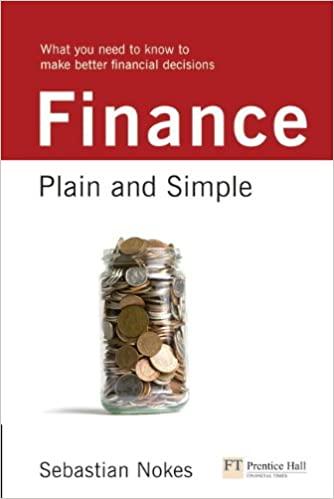can u help me to solve from part 2 of "a" to the "c" part.
Thanks!
Re Homework: MyFinanceLab (Graded) Assignment 2 Save Score: 0 of 5 pts 18 of 20 (17 complete) HW Score: 80%, 80 of 100 pts P5-28 (similar to) Question Help Your friend tells you he has a very simple trick for taking one-third of the time it takes to repay your mortgage: Use your Christmas bonus to make an extra payment on January 1 of each year (that is, pay your monthly payment due on that day twice). Assume that the mortgage has an original term of 30 years and has an APR of 12%. a. If you take out your mortgage on January 1 (so that your first payment is due on February 1), and you make your first extra payment at the end of the first year, in what year will you finish repaying your mortgage? b. you take out your mortgage on July 1 (no that the first payment is on August 1), and you make the extra payment each January, in how many months will you pay off your mortgage? c. How will the amount of time it takes to pay off the loan given this strategy vary with the interest rate on the loan? a. If you take out your mortgage on January 1 (so that your first payment is due on February 1), and you make your first extra payment at the end of the first year, in what year will you finish repaying your mortgage? The loan payment is $ 1028.61. (Round to the nearest cent.) The approximate number of years is (Round to no decimal places.) Enter your answer in the answer box and then click Check Answer. parts 4 remaining Clear All Check Answer or X ar X That's Incorrect. ou Next we write out the cash flows with the extra payment (shown in the second line): Month 0 1 12 13 24 25 N Cash flow $100,000 - $1,028.61 - $1,028.6+ $1,028.61 - $1,028.6+$1,028.61 $1,028.61 $1,028.61 - $1.028.61 Let's find the equivalent one time annual payment to these cash flows (as though we only made a single payment each February). The future value of the above cash flows is the future value of the monthly annuity plus the future value of the extra January payment: Loan payment FV4 ye monthly interest rate ((1+ monthly interest rate)-1)+Loan payment x (1 + monthly interest rate) So, the new payment plan is equivalent to paying the FV found above at the end of every year. At that rate, how long will it take to pay off the Joan? We need to find the number of years N for an annual annuity, such that given an EAR of (1.01)12 = 1.12683 - 1, the PV = $100,000: FV $100,000 = (1 + monthly interest rate) - 1 1+ ((1 + monthly interest rate) - 1) We can solve for N using an annuity calculator, with Excel (NPER function), by trial and error. (--(+6 1)") OK Re Homework: MyFinanceLab (Graded) Assignment 2 Save Score: 0 of 5 pts 18 of 20 (17 complete) HW Score: 80%, 80 of 100 pts P5-28 (similar to) Question Help Your friend tells you he has a very simple trick for taking one-third of the time it takes to repay your mortgage: Use your Christmas bonus to make an extra payment on January 1 of each year (that is, pay your monthly payment due on that day twice). Assume that the mortgage has an original term of 30 years and has an APR of 12%. a. If you take out your mortgage on January 1 (so that your first payment is due on February 1), and you make your first extra payment at the end of the first year, in what year will you finish repaying your mortgage? b. you take out your mortgage on July 1 (no that the first payment is on August 1), and you make the extra payment each January, in how many months will you pay off your mortgage? c. How will the amount of time it takes to pay off the loan given this strategy vary with the interest rate on the loan? a. If you take out your mortgage on January 1 (so that your first payment is due on February 1), and you make your first extra payment at the end of the first year, in what year will you finish repaying your mortgage? The loan payment is $ 1028.61. (Round to the nearest cent.) The approximate number of years is (Round to no decimal places.) Enter your answer in the answer box and then click Check Answer. parts 4 remaining Clear All Check Answer or X ar X That's Incorrect. ou Next we write out the cash flows with the extra payment (shown in the second line): Month 0 1 12 13 24 25 N Cash flow $100,000 - $1,028.61 - $1,028.6+ $1,028.61 - $1,028.6+$1,028.61 $1,028.61 $1,028.61 - $1.028.61 Let's find the equivalent one time annual payment to these cash flows (as though we only made a single payment each February). The future value of the above cash flows is the future value of the monthly annuity plus the future value of the extra January payment: Loan payment FV4 ye monthly interest rate ((1+ monthly interest rate)-1)+Loan payment x (1 + monthly interest rate) So, the new payment plan is equivalent to paying the FV found above at the end of every year. At that rate, how long will it take to pay off the Joan? We need to find the number of years N for an annual annuity, such that given an EAR of (1.01)12 = 1.12683 - 1, the PV = $100,000: FV $100,000 = (1 + monthly interest rate) - 1 1+ ((1 + monthly interest rate) - 1) We can solve for N using an annuity calculator, with Excel (NPER function), by trial and error. (--(+6 1)") OK








